The Notre Dame Towers Of Paris – Gargoyles & Quasimodo
Without the swift action by Paris firefighters the iconic Notre Dame towers would have fallen in the fire of April 15, 2019. Thankfully, the pompiers focused their efforts on preventing the fire from reaching the two bell towers, and that's what saved the entire structure, since the towers act as pillars that keep the building erect. Let's discover more about this Paris landmark destination that inspired Victor Hugo to pen his famous novel The Hunchback of Notre Dame featuring Quasimodo, the bell-ringer with a heart of gold.
![]()
Our Top-Rated Paris Experiences
1. Seine River Romantic Dinner Cruise… With live music & champagne
2. Cheese and Wine Tasting in a Private Paris Cheese Cellar… Learn from a Master Affineur
3. Louvre Masterpieces Tour… Skip the lines for the best experience
4. Dinner Cruise with Maxim's of Paris… An Art Nouveau experience from 1900
The Fire That Almost Toppled Notre Dame's Towers
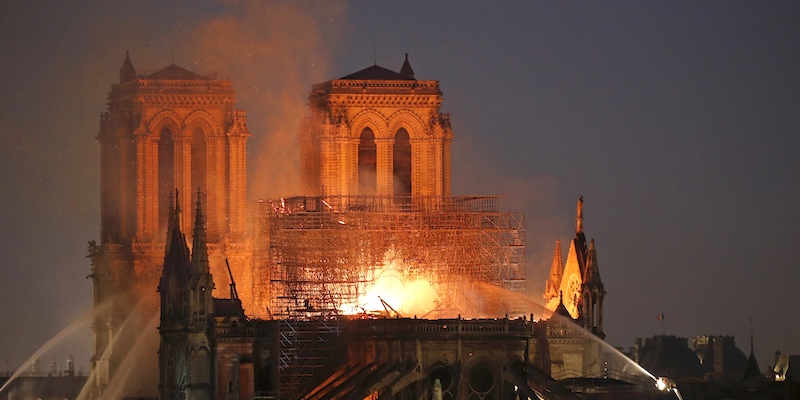 Fire threatening the towers, photo Christophe Ena, AP
Fire threatening the towers, photo Christophe Ena, AP
The massive fire that threatened to destroy Notre-Dame Cathedral stunned France and the world. The flames reached scorching temperatures of over 800° C (that's 1500° F), obliterating the roof of the Paris landmark. Luckily, the five hundred Parisian firefighters were able to save the two main bell towers and the outer walls of the medieval building.
First responders acted quickly and put in place a strategy to prevent a collapse of the cathedral. In doing so they managed to save the main structure, the towers, and the majority of the relics and artworks. Even the cathedral's three large stained-glass rose windows survived. If the towers' wooden frames had caught fire it would have caused the bells — including the mammoth Emmanuel bell, weighing in at 13 tonnes — to come crashing down. This would have been catastrophic, probably resulting in the collapse of both Gothic towers.
The flames that began in around 6:30 PM on April 15, 2019 spread rapidly through the roof of the nearly 900-year-old cathedral, engulfing the spire, which toppled, followed by the entire wooden roof. After fighting the flames through the night, the fire was extinguished early the next morning. In addition to saving the bell towers firefighters rescued about 90% of the cathedral's religious relics and artwork. Notre Dame's main stone structure escaped destruction only because the fire at the towers was brought under control.
Amazingly, only one firefighter was seriously injured. Experts believe there was further damage from the incredible quantities of water used to quench the fire. Both towers came through the conflagration safely and still stand as symbols of the historic cathedral as it progresses through restoration work.
![]()
Discover What's On When You're Here...
• January... |
• February... |
• March... |
• April... |
• May... |
• June... |
• July... |
• August... |
• September... |
• October... |
• November... |
• December... |
Discover What's On When You're Here
• January...
|
• February... |
• March... |
|---|---|---|
• April... |
• May... |
• June... |
• July... |
• August... |
• September... |
• October... |
• November... |
• December... |
A Gargoyle's View on Paris
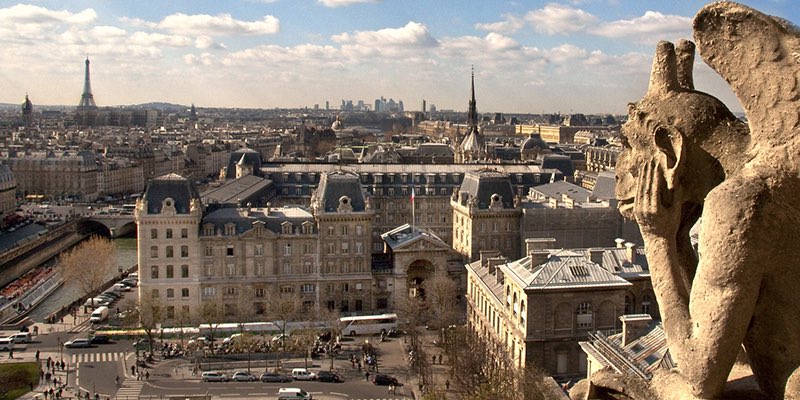 View of Paris from the Notre Dame Towers, photo by Mark Craft
View of Paris from the Notre Dame Towers, photo by Mark Craft
The celebrated twin bell towers of Notre Dame Cathedral have been watching over Paris for nine centuries. Before the fire it was possible to climb to the top via a narrow winding stone staircase.
The 387-step climb rewarded the visitor with a gargoyle's view of the oldest areas of Paris. From the top the glories of the city lay beneath you and the stellar views make for one of the greatest Paris photo opportunities. You could see Paris on a human scale and get a feeling for what the medieval city was like. In fact, for hundreds of years the towers provided the best panoramic view of the City of Light. With any luck, we'll be able to enjoy this view again, once the restoration is completed. (Check this space in five years!)
![]()
Romantic Dinner Cruises In Paris
|
VIP Dinner Cruise with Bateaux Parisiens |
Dinner Cruise by Maxim's of Paris |
|
VIP Dinner Cruise with Bateaux Parisiens |
What's With Those Gargoyles?
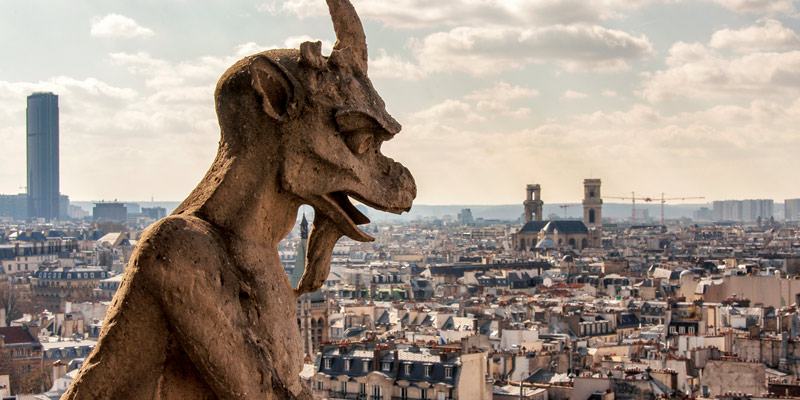 A gargoyle overlooks Paris, photo by Mark Craft
A gargoyle overlooks Paris, photo by Mark Craft
The gargoyles that adorn Notre Dame actually have a practical purpose. While some are just for decoration, in the main they are placed to provide proper roof drainage. The gargoyles with their big mouths are located at the ends of the gutters to drain water away from the sides to prevent water damage to the stone walls and foundation. Most of the original gargoyles were destroyed during the French Revolution (along with other statuary on the cathedral) but were replaced during a 19th-century restoration.
![]()
Top-Rated Paris Museum Tours
|
The Louvre's Greatest Masterpieces |
Musé d'Orsay Guided Tour |
|
The Louvre's Greatest Masterpieces |
Guided City Walk – Notre Dame Cathedral & Île de la Cité
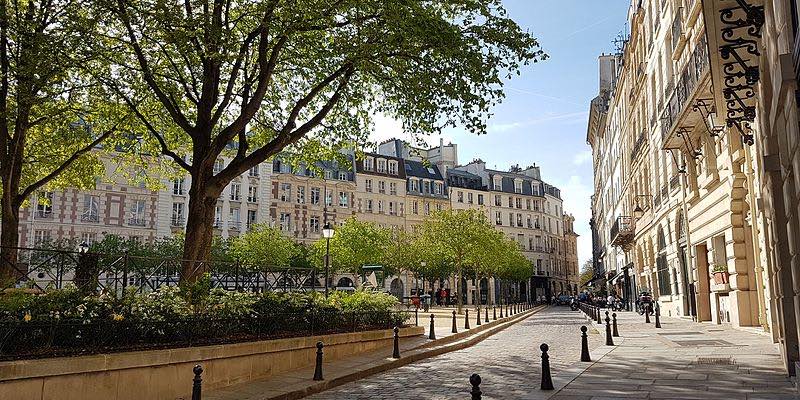 Place Dauphine on Île de la Cité, photo Wikimedia by Koudkeu
Place Dauphine on Île de la Cité, photo Wikimedia by Koudkeu
She's down but not out. The world shuddered as flames tore through Notre Dame de Paris. Today, as medieval experts, engineers, architect, and builders resurrect the cathedral, a special tour has been designed to take you to the center of Paris to learn about the amazing history of this iconic Parisian church and other landmarks sarong the island with her.
As you admire the 860-year-old cathedral (from the outside, of course), your guide will regales you with the tale of Notre Dame from its beginning as a royal church in the Middle Ages to when Napoleon I was crowned, as well as its role during the Liberation of Paris in 1944. You also visit historic La Saint Chapelle with its amazing stained glass walls; Pont Neuf, the oldest bridge in Paris; and the Conciergerie.
Secrets & Fun Facts About the Notre Dame Towers
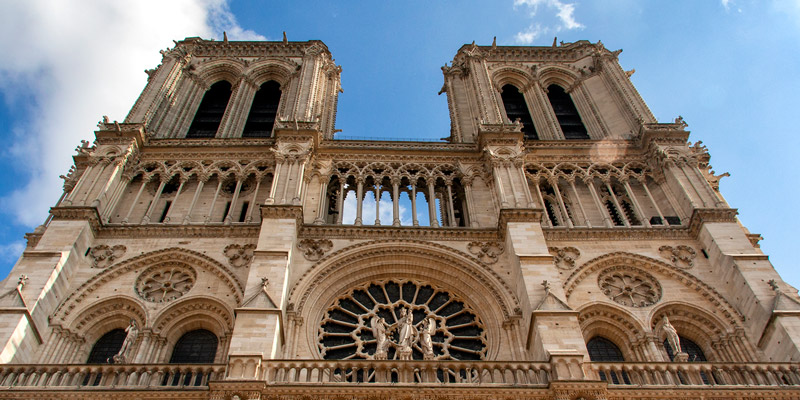 The Notre Dame Towers in 2012, photo by Mark Craft
The Notre Dame Towers in 2012, photo by Mark Craft
- At 69 meters the Notre Dame towers were the tallest structures in Paris until the Eiffel Tower was built in 1889.
- The towers were completed between 1240 and 1250. The north tower is slightly larger.
- Midway up the top you can stop at the Gothic hall with the rose window to see paintings and sculptures from the cathedral's history.
- There are ten bells and the are all housed in the south tower. (To the right as you face the front of the cathedral.)
![]()
Two Of The Most Popular Paris Experiences
|
VIP Dinner Cruise with Bateaux Parisiens |
Versailles with Priority Access + Gardens |
The Most Popular Paris Experience
|
VIP Dinner Cruise with Bateaux Parisiens |
What Can You See from the Towers?
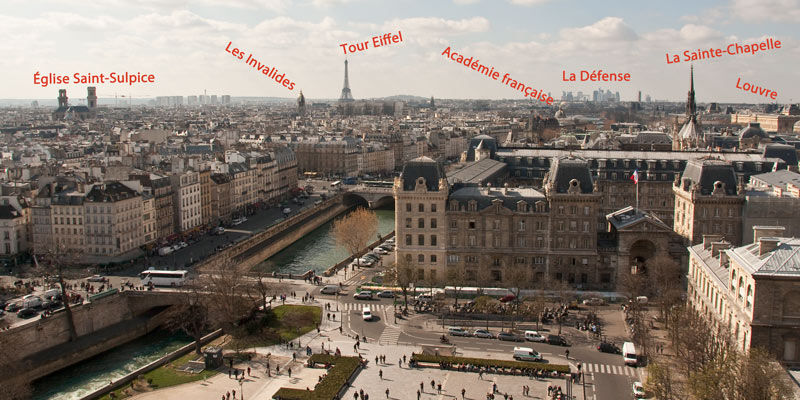 What you can see from the towers, photo by Mark Craft
What you can see from the towers, photo by Mark Craft
You see the heart of Paris, where every building and every street is steeped in history. Below you is the Seine River, the forecourt (parvis) of the cathedral, the historic buildings of île de la Cité. Close by you can spot the Pantheon, the mismatched towers of Église Saint-Sulpice, the dome of Val de Grace. In the distance is the Eiffel Tower, Montmartre & Sacre-Coeur, and the modern buildings of La Défense. The story of Paris is being told all around you.
Notre Dame Cathedral Towers Resources
- Rue du Cloître Notre-Dame
- île de la Cité, 4th Arrondissement
- Metro – Cité
![]()
The Best Evenings in Paris
|
Dinner & Cabaret at the Moulin Rouge |
VIP Dinner Cruise with Bateaux Parisiens |
|
Dinner & Cabaret at the Moulin Rouge |
A Capsule History of Notre Dame Cathedral
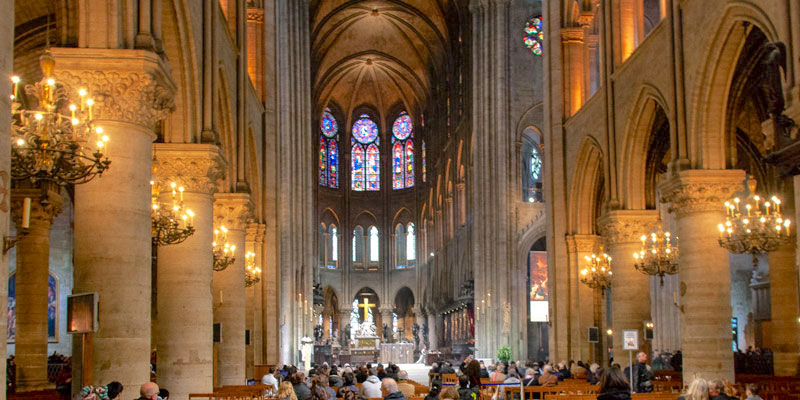 The interior of Notre Dame, 2012, photo by Mark Craft
The interior of Notre Dame, 2012, photo by Mark Craft
The year is 1163 and construction on Notre Dame cathedral has begun. These first builders will not live to see the finished cathedral, nor will their children. It will take almost 200 years to complete.
During the French Revolution the cathedral is severely damaged by the angry mobs. Restoration of the cathedral doesn't start until 1845, half a century later, with French architect Eugene Viollet-le Duc (1814-1879) supervising the huge undertaking.
The towers are home to the cathedral's largest bell, Emmanuel, the tenor bell, that weighs in at thirteen tons. In fact, there are ten bells in the Notre Dame towers. Emmanuel, the oldest and the biggest, rings on the hour. On August 24, 1944, Emmanuel's bell can be heard to announce the liberation of Paris.
The 12th-century Gothic wonder is now listed as a UNESCO World Heritage site. Under a 1905 law, Notre-Dame Cathedral is owned by the French State and managed by the Catholic Church.
On April 15, 2019 a fire ravages our Lady of Paris, nearly destroying her 900-year history. Lucky for the world, the main building and the twin bell towers stand even though the roof and spire are destroyed.
Paris Planning Guides
 Book an Airport Transfer
Book an Airport Transfer |
 Left Bank Hotels
Left Bank Hotels |
 Paris Metro Guide
Paris Metro Guide |
 Glorious Dinner Cruises
Glorious Dinner Cruises |












